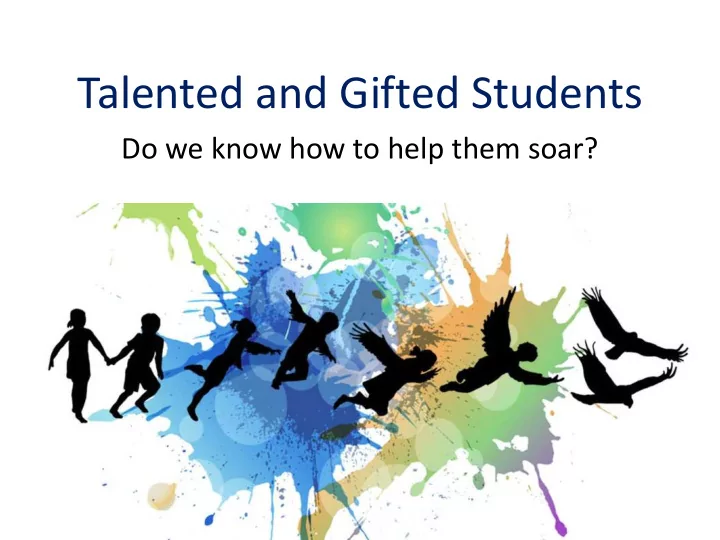

Talented and Gifted Students Do we know how to help them soar?
TAG Talented And Gifted Students who show extraordinary potential for achievement and who require services not ordinarily provided.
Talented and Gifted Education Act 1987 “Oregon Revised Statute: 343.407: Identification of talented and gifted students: School districts shall identify talented and gifted students enrolled in public schools under rules adopted by the State Board of Education.” Oregon Revised Statute 343.409: Talented and Gifted Programs Required. “School districts shall provide educational programs or services to talented and gifted students enrolled in public schools under rules adopted by the State Board of Education.”
Administrative Rules Instructional Best Practices: i. TAG individual PEP (personal education plans) are optional, but serve the needs of TAG learners as a road map for instruction. ii. Rate and Level
Identification in SFSD • Multiple Standardized Scores in top 3% Nationally. • Parent and Teacher Feedback • District or State level Committee – The questions they ask – The way they approach problems “Talent hits a target no one else can hit. Genius hits a target no one else can see.”
Services in SFSD • Instructional Grouping/Scheduling • Differentiated Plan of Instruction (DPI) – Identify what each learner needs in their learning environment to address their rate and level of learning. – Identify Social-Emotional Needs
Rate and Level Rate: • A measure of the pace at which the student is successfully progressing through the curriculum after being placed at the appropriate level. A student’s rate will vary depending on subject, interest, level of difficulty and point in the learning process
Level: The student’s instructional level in the curriculum and the place where the student will encounter knowledge and skills not yet learned or mastered. It more than an advanced grade level. It involves depth and complexity in thinking.
Understanding the Social-Emotional Characteristics of Gifted
From the Headlines… Existential Depression: the Disease of the Gifted and Talented Why Gifted Children are Anxious Perfectionism and Anxiety: A Paradox of Giftedness The Problem with Being Gifted Gi Gifte fted Ki Kids at t Risk: Who’s Liste tening Depressive Disorder in Highly Gifted Adolescents Why School’s Not Fair for Gifted Kids Legal Issues and the Gifted: Implications for Education
• Perfectionism • Underachievement • Overexcitabilities (Supersensitivities/Intensities) • Asynchronous Development • Academic and Social Disconnect • Fixed Mindset
Overexcitabilities Overexcitabilities are inborn intensities indicating a heightened ability to respond • to stimuli. Found to a greater degree in creative and gifted individuals, overexcitabilities are • expressed in increased sensitivity, awareness, and intensity, and represent a real difference in the fabric of life and quality of experience. Dabrowski identified five areas of intensity-Psychomotor , Sensual, Intellectual, • Imaginational, and Emotional. A person may possess one or more of these. “One who manifests several forms of overexcitability, sees reality in a different, stronger and more multisided manner” (Dabrowski, 1972, p. 7). Experiencing the world in this unique way carries with it great joys and • sometimes great frustrations. The joys and positives of being overexcitable need to be celebrated. Any frustrations or negatives can be positively dealt with and used to help facilitate the child’s growth.
Asynchronous Development Asynchrony is the term used to describe the mismatch between cognitive, • emotional, and physical development of gifted individuals. Gifted children often have significant variations within themselves and • develop unevenly across skill levels. For example, a gifted child may be excellent in math, but poor in reading--or vice versa. Often, intellectual skills are quite advanced, but fine motor or social skills • are lagging. asynchrony is so prominent in gifted children, some professionals believe • asynchronous development rather than potential or ability, is the defining characteristic of giftedness. It is important for parents, teachers, and caregivers to realize that "one • size does not fit all" for gifted children--and even those with similar IQ scores may not have similar skills, personalities, rates of development, abilities, or interests. The individual traits of one gifted child may be extremely different from • another. And, the more highly gifted the gifted child, the more asynchronous she may be.
“The Duality of Giftedness” The Child Who… Often also …____________ Shows superior reasoning Is impatient, arrogant, and challenges authority Can solve problems Quickly/easily Gets bored and frustrated Shows curiosity and asks questions Asks inappropriate questions Shows exceptional interest in the big picture Feels interests of peers are trivial and meaningless Has wide range of interests of considerable depth Seems scattered, obsesses/ hyper-focuses
Has advanced vocabulary Dominates discussion, uses words to intimidate or show off Is an avid reader/learner Avoids social interaction Learns quickly; comprehends readily Gets impatient, resists anything that is not a new opportunity Is creative and imaginative Goes too far, is disruptive and goes off subject Sustains concentration for lengthy periods Has tunnel vision, is stubborn, doesn’t transition well Shows outstanding independent learning Has difficulty collaborating, is bossy, unable to accept help
Resources for Parents https://www.oregon.gov/ode/learning-options/TAG/Pages/Your-Gifted-Child.aspx • https://oedb.org/ilibrarian/50-essential-links-for-the-parents-of-gifted-children/ • https://www.giftedstudy.org/beyond/online/ • Institute for Educational Advancement: https://educationaladvancement.org/ • • Gilbert House Children’s Museum: http://acgilbert.org/ Willamette Heritage Center: https://www.willametteheritage.org/ • OMSI: https://omsi.edu/ • OSU Youth Programs & Precollege Programs: http://precollege.oregonstate.edu/ • Straub Environmental Center: https://www.straubcenter.org/ • Young Musicians & Artists: https://www.ymainc.org/info/ • • Oregon Promise: https://oregonstudentaid.gov/oregon-promise.aspx Willamette Promise: https://www.wesd.org/willamettepromise • College Credit Now: https://www.chemeketa.edu/programs-classes/high-school- • programs/college-credit-now/ http://www.giftedguru.com/resources-for-parents/ •
Recommend
More recommend